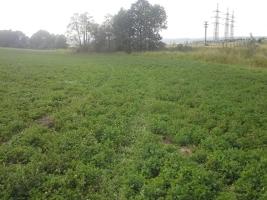
Red Clover
Red clover is capable of producing high yields of highly digestible, high protein silage without the need for any inorganic N fertiliser
Introduction
Like white clover it can fix its own N via bacteria located on root nodules. This can be worth up 200kg N/ha per year. Unlike white clover, red clover has an erect growth habit and a strong taproot that leads to strong summer growth and a degree of drought tolerance. Due to its upright growth habit and high summer yields red clover is better suited to cutting than grazing. N Saver Silage from DLF is designed to produce high protein silage with minimal N fertiliser input.
Benefits of Red Clover
- Can produce between 14 and 16 tons DM/ha when grown with perennial ryegrass
- Annual N fixation of 150-200kg N/ha is possible from swards with a high red clover content
- High crude protein content of 16-20%
- Highly palatable leading to increased animal intake and performance
- Deep tap root makes red clover relatively drought tolerant compared to grass silage mixtures

Establishing & Managing Red Clover
- Red clover requires high soil fertility for maximum production. Index 3 for P and K and soil pH 6.0-6.5 is desirable
- Sow red clover from April to July when soil temperatures are above 10°C
- Red clover is best sown in a mixture with perennial ryegrass and some white clover. A typical seed rate for a clover dominant sward would be 4kg/acre of red clover, 6kg/acre perennial ryegrass and 1kg/acre white clover. Arable silage crops can also be undersown with red clover
- Ensure a fine, firm seedbed and roll before and after shallow sowing <1cm deep
- A typical cutting strategy for red clover would be to harvest first cut in mid-late May with the second, third and fourth cuts at 6-8 week intervals thereafter
- The final cut should be taken no later than October. This may take the form of a light grazing or zero-graze
- Silage crops should be cut down to 6cm
- Crops can be autumn grazed in suitable conditions to leave an over-winter cover of 6cm
- Avoid cutting in wet weather
- Red clover is a low sugar, low DM crop so wilt for 24-48 hours to achieve 25-35% DM to aid preservation
- Do not use a conditioner mower and avoid excessive handling of the crop to reduce leaf loss
- Allowing red clover to flower once a year can help with persistence. Flowering will occur naturally in late summer so there is no need to delay any harvest – especially the first one.
- Slurry and FYM can be applied throughout the year to replenish P and K
Learn More About Red Clover
Want to know more? Reach out to your local DLF representative today or leave us a message using our chat widget!